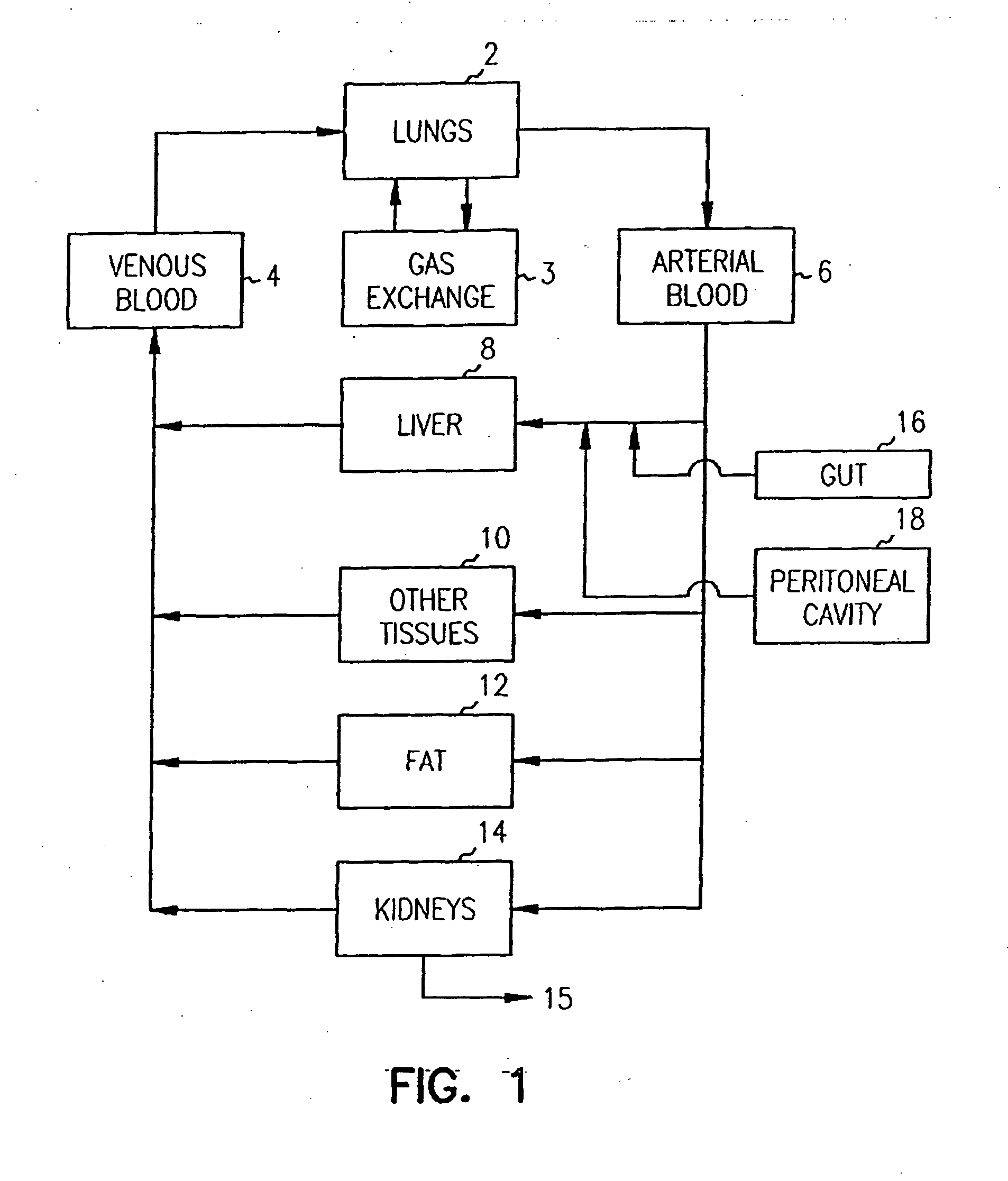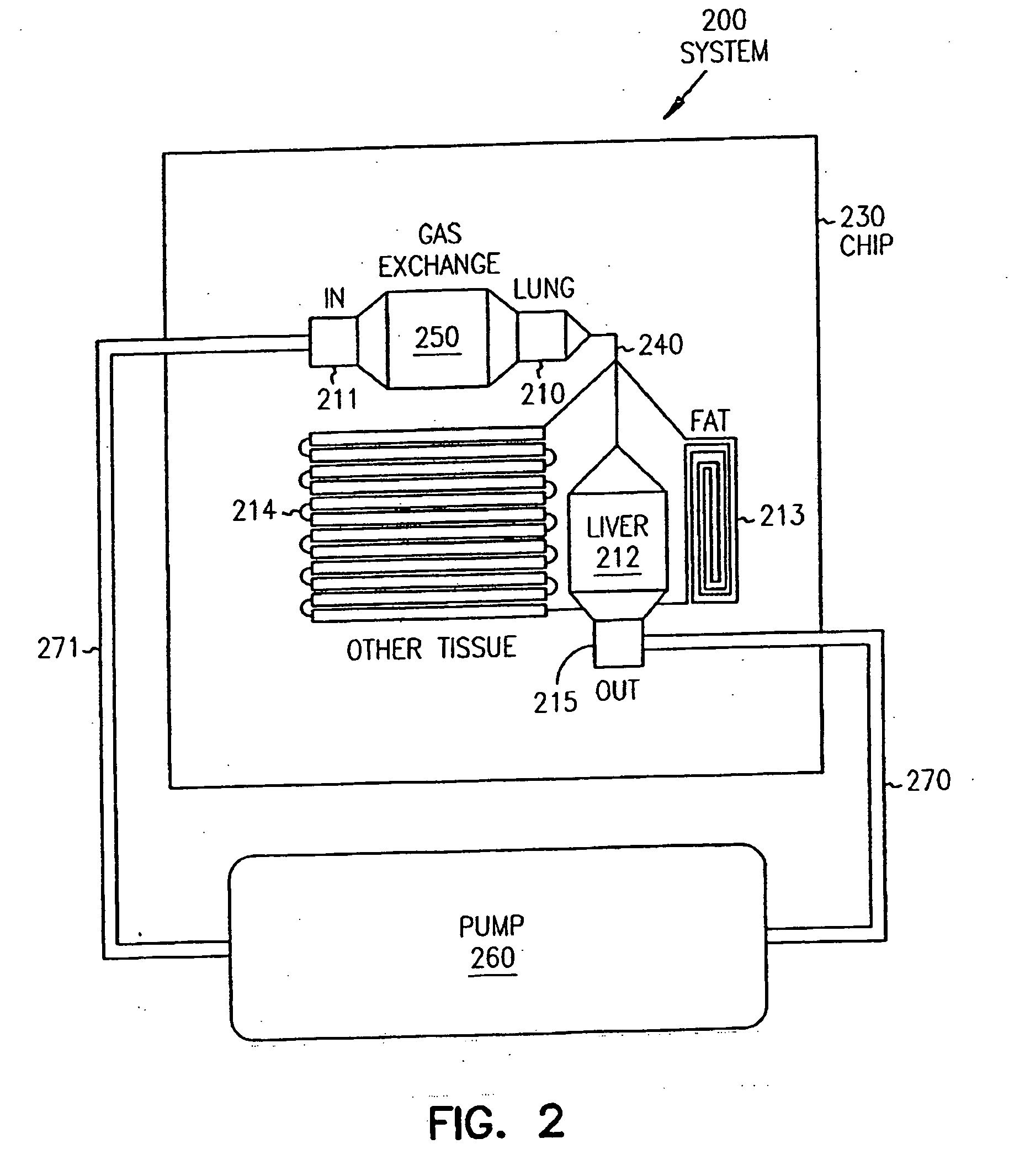Biliary barrier
a biliary barrier and membrane technology, applied in the field of cell culture technology, can solve the problems of unrealistic ratio of cell types, non-physiological high liquid-to-cell ratio, and still substantial limitations, and achieve the effect of enhancing the predictive value and in vivo relevance of screening and toxicity assays
- Summary
- Abstract
- Description
- Claims
- Application Information
AI Technical Summary
Benefits of technology
Problems solved by technology
Method used
Image
Examples
example 1
Calculations for a System Replicating a Rat
[0288] In designing the chip 1000 all necessary chambers were fit onto a silicon chip no larger than 2 cm by 2 cm. This size of chip is easy to manufacture and is compatible with the sizes of connective tubing and pumping devices intended for use to direct fluid flow. There were also several other important factors constraining the design of the device listed below, along with acceptable values for each variable. This one embodiment of the device consists of a two compartment system, one compartment representing the liver of a rat and one compartment representing the lung of a rat. The total size of the chip is 2 cm by 2 cm and consists of an interconnected array of 20 parallel channels 40 μm wide, 10 μm deep and 5 mm long to serve as the “lung” chamber and two parallel channels 100 μm wide, 20 μm deep and 10 cm long in a serpentine shape to serve as the “liver” chamber. The two organ compartments are connected by a channel 100 μm wide and...
example 2
A Four Organ Compartment Chip
[0311] A chip was designed to consist of four organ compartments—a “liver” compartment to represent an organ responsible for xenobiotic metabolism, a “lung” compartment representing a target tissue, a “fat” compartment to provide a site for bio-accumulation of hydrophobic compounds, and an“other tissues” compartment to assist in mimicking the circulatory pattern in non-metabolizing, non-accumulating tissues (FIG. 15). These and other organ compartments (e.g., kidney, cardiac, colon or muscle) can be fully modularized as CAD files and can be fabricated in any configuration or combination. The device itself can be produced in any number of substrates (e.g., silicon, glass, or plastic).
[0312] Once the cells were seeded in the appropriate compartments, the chip was assembled in a Lucite manifold. This manifold holds four chips and contained a transparent top so the cells could be observed in situ. The top contained fluid interconnects to provide cell cultu...
example 3
Drug Metabolism in the Chip
[0314] The metabolism of two widely used prodrugs, tegafur and sulindac sulfoxide, was studied using a microscale chip comprising three compartments, liver, target tissue, and other tissues. Both prodrugs require conversion to an active metabolite by enzymes present in the liver, and have a cytotoxic effect on a target organ. For the prodrug sulindac sulfoxide, its anti-inflammatory and cancer chemopreventive properties are derived from its sulfide and sulfone metabolites, catalyzed by the liver enzyme sulfoxide reductase. The sulfide metabolite (and a second sulfone metabolite) have been demonstrated to induce apoptosis in certain cancer cells (e.g., colon cancer).
[0315] A proper treatment regimen requires administration of its prodrug, tegafur [5-fluoro-1-(2-tetrahydrofuryl)-2,4(1H,3H)-pyrimidi-nedione] as 5-FU itself is quite toxic to normal cells. Unlike sulindac however, tegafur is converted to 5-FU in the liver primarily by cytochrome P450 2A6.
[03...
PUM
| Property | Measurement | Unit |
|---|---|---|
| volume | aaaaa | aaaaa |
| residence time | aaaaa | aaaaa |
| volume | aaaaa | aaaaa |
Abstract
Description
Claims
Application Information
 Login to View More
Login to View More - R&D
- Intellectual Property
- Life Sciences
- Materials
- Tech Scout
- Unparalleled Data Quality
- Higher Quality Content
- 60% Fewer Hallucinations
Browse by: Latest US Patents, China's latest patents, Technical Efficacy Thesaurus, Application Domain, Technology Topic, Popular Technical Reports.
© 2025 PatSnap. All rights reserved.Legal|Privacy policy|Modern Slavery Act Transparency Statement|Sitemap|About US| Contact US: help@patsnap.com



